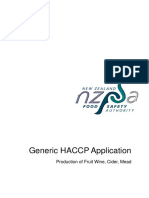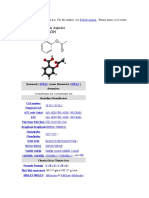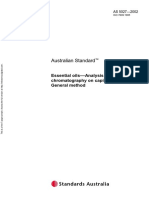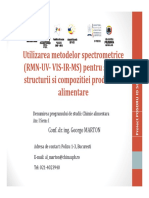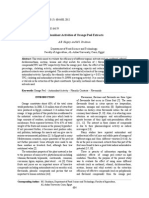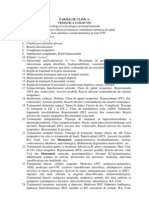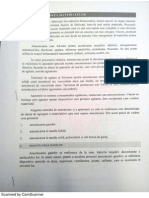Resveratrol
Resveratrol
Uploaded by
Sava1988Copyright:
Available Formats
Resveratrol
Resveratrol
Uploaded by
Sava1988Original Description:
Copyright
Available Formats
Share this document
Did you find this document useful?
Is this content inappropriate?
Copyright:
Available Formats
Resveratrol
Resveratrol
Uploaded by
Sava1988Copyright:
Available Formats
36
J. Nat. Prod. 2005, 68, 36-42
Viniferin Formation by COX-1: Evidence for Radical Intermediates during Co-oxidation of Resveratrol
Lawrence M. Szewczuk,, Seon Hwa Lee, Ian A. Blair, and Trevor M. Penning*,
Department of Biochemistry and Biophysics and Department of Pharmacology, University of Pennsylvania School of Medicine, Philadelphia, Pennsylvania 19104 Received September 8, 2004
Resveratrol (1) is a polyphenolic natural product, which functions as both a mechanism-based inactivator and a co-reductant of the COX-1 peroxidase. These functions are mediated through different moieties on the molecule, namely, the m-hydroquinone moiety (mechanism-based inactivator) and the phenol moiety (co-reductant). Implicit in this bifunctionality is the notion that resveratrol is oxidized at the peroxidase active site of COX-1, resulting in the formation of two hypothetical radical species. Oxidation of the m-hydroquinone moiety can generate a hypothetical m-semiquinone radical, which is unstabilized and leads to irreversible enzyme inactivation. Oxidation of the phenol moiety can generate a hypothetical phenoxy radical, which is stabilized and leads to co-reduction during peroxidase catalysis. These two radicals have been trapped as the resveratrol dimers, cis- -viniferin (4, trapped m-semiquinone radical) and trans--viniferin (5, trapped phenoxy radical), and identified by liquid chromatography (LC), absorbance spectroscopy, and LC/tandem mass spectrometry (MSn) methods. Methoxy-resveratrol analogues, in which either the m-hydroquinone or the phenol moiety were protected as methyl ethers, were used to confirm the proposed mechanism of viniferin production by COX-1. Prostaglandin (PG) H2 synthases (COX-1 and COX-2) are Fe-protoporphyrin-IX (FePPIX, heme)-dependent enzymes that function as both a bis-dioxygenase (cyclooxygenase reaction) and a peroxidase to sequentially transform arachidonic acid (AA) to PGH2.1-3 This represents the first committed step in the biosynthesis of all PGs, which are important in maintaining vascular homeostasis (primarily COX-1) and mediating symptoms of inflammation (primarily COX-2).3-8 The catalytic mechanism requires the peroxidase activity to initiate the cyclooxygenase reaction by generating a tyrosyl radical (Figure 1A). After initiation, the cyclooxygenase activity becomes autocatalytic. In contrast, the peroxidase activity requires a co-reductant to return the heme Fe from the higher oxidation states generated during peroxidase catalysis [compound I (Fe5+) and compound II (Fe4+)] to its resting state (Fe3+), before peroxide bond cleavage can occur again.9-11 Both enzyme isoforms self-inactivate over time due to protein radical intermediates generated when there is insufficient coreductant.12,13 The discrete mechanism of enzyme selfinactivation and the identity of the terminal enzyme complex are currently unknown. Resveratrol (1) (3,5,4-trihydroxy-trans-stilbene; Figure 2) is a common natural product found in grape skins and many other plants that has cardiovascular-protective, cancer-chemopreventive, and antiinflammatory properties.14 This polyphenolic compound targets the COX-1 peroxidase.14,15 With respect to this active site, resveratrol acts as a selective mechanism-based inactivator, thereby eliminating all PG biosynthesis by this isoform.16 Selective inactivation of COX-1 and not COX-2 may contribute to the cardioprotective properties of resveratrol.17-19
* To whom correspondence should be addressed. Tel: (215) 898-9445. Fax: (215) 573-2236. E-mail: penning@pharm.med.upenn.edu. Department of Biochemistry and Biophysics, University of Pennsylvania School of Medicine. Current address: Department of Pharmacology and Molecular Sciences, Johns Hopkins University School of Medicine, Baltimore, MD 21205. Department of Pharmacology, University of Pennsylvania School of Medicine.
Figure 1. Proposed radicals formed upon resveratrol oxidation by COX-1, where PPIX stands for protoporphyrin-IX (heme).
Resveratrol (1) contains two functional moieties, namely, a m-hydroquinone moiety and a phenol moiety, on opposite rings (Figure 2). Mechanism-based inactivation of COX-1 by resveratrol has an obligatory requirement for a peroxide cosubstrate and the m-hydroquinone moiety and is not accompanied by the incorporation of [3H]-resveratrol into COX-1 even though resveratrol undergoes enzymatic oxi-
10.1021/np049702i CCC: $30.25
2005 American Chemical Society and American Society of Pharmacognosy Published on Web 12/31/2004
Viniferin Formation by COX-1
Journal of Natural Products, 2005, Vol. 68, No. 1 37
In this study we provide evidence for the formation of both the unstabilized m-semiquinone radical implicated in mechanism-based inactivation of COX-1 and the stabilized phenoxy radical implicated in co-reduction. Our results show that oxidation of resveratrol (1) by the COX-1 peroxidase leads to the formation of two major products, namely, the resveratrol dimers, cis- -viniferin (4) and trans-viniferin (5; Figure 2). Identity of these viniferins was established by liquid chromatography (LC), ultraviolet/ visible (UV/vis) absorbance spectroscopy, and LC/UV/mass spectrometry (MS). These products represent the trapped m-semiquinone (4) and phenoxy (5) radicals proposed. Furthermore, the discrete mechanism of viniferin production by COX-1 was confirmed by product profile studies with methoxy(OMe)-resveratrol analogues which showed that dimer formation occurred via oxidation of the unprotected hydroxyl groups. On the basis of our results, we provide evidence for the formation of two resveratrol radicals implicated in COX-1 inactivation and co-reduction and discuss the implications of viniferin production by COX-1. Results and Discussion RP-HPLC Analysis of [3H]-Resveratrol Products Isolated from Inactivated COX-1. Previous studies showed that inactivation of COX-1 by resveratrol (1) in the presence of H2O2 occurred via a hit-and-run mechanism without covalent incorporation of resveratrol into the enzyme.16 To isolate the products resulting from this reaction, C4 RP-HPLC analysis was performed on [3H]resveratrol inactivated COX-1 that was isolated by Sephadex G-25 chromatography. This analysis yielded one retained peak of radioactivity (21.7 min; Figure 3A), which did not correspond to the absorbance peak for COX-1 (26.9 min; Figure 3B). This confirmed our previous finding that mechanism-based inactivation of COX-1 by [3H]-resveratrol resulted in the formation of [3H]-product that comigrated with the enzyme on Sephadex G-25, but was dissociated by RP-HPLC, indicating a noncovalent interaction.16 Subsequent C18 RP-HPLC analysis on this sample yielded two retained peaks of radioactivity (Figure 3C). In this system, the previously observed retained peak (Figure 3A) was resolved as two distinct species with retention times of 12.5 min (4) and 20.8 min (5) in the radiochromatogram and 12.1 min (4) and 20.5 min (5) when the absorbance was monitored at 220 nm (Figure 3D). Neither peak corresponded to resveratrol (1), which eluted with a retention time of 14.5 min in this system (Figure 4A). The UV/vis spectrum for 4 was indicative of the presence of a cis-resveratrol moiety, which has max of 286 nm (E286 nm ) 13 100 M-1 cm-1), whereas the UV/vis spectrum for 5 was indicative of the presence of a trans-resveratrol (1) moiety, which has max of 306 nm (E306 nm ) 31 800 M-1 cm-1; Figure 3E and 3F).23 Samples that were prepared without the preceding Sephadex G-25 chromotography step also yielded 4 and 5 as oxidation products (Figure 4B). Furthermore, 4 and 5 are enzyme generated, since they were not produced in reactions lacking COX-1 (Figure 4C). Instead, in the presence of excess FePPIX, resveratrol (1) is oxidized to a product that is not retained (Figure 4C). All additional analysis of 4 and 5 was performed on samples that had not been purified by Sephadex G-25 chromatography. Identification of Resveratrol Oxidation Products. LC, UV/vis absorbance spectroscopy, and LC/UV/MS analysis were used to identify the two enzyme-generated resveratrol (1) oxidation products (Table 1). The LC/UV/MS
Figure 2. Structures of resveratrol, its methoxy analogues, and its COX-1 oxidation products.
dation. It has been proposed that resveratrol inactivates COX-1 by a hit-and-run mechanism in which a hypothetical m-semiquinone radical is formed at the peroxidase active site upon oxidation of the m-hydroquinone moiety.16 This radical cannot be stabilized through the ring structure of the m-hydroquinone (Figure 1B).20 It is likely that this unstabilized radical can facilitate the generation of a protein radical leading to inactivated enzyme. In this manner, mechanism-based inactivation of COX-1 by resveratrol may be similar to the natural phenomenon of enzyme self-inactivation. Evidence for the hypothetical m-semiquinone radical is lacking. Although COX-2 is a more robust catalyst for m-hydroquinone oxidation, this isoform is not susceptible to inactivation by resveratrol. It was proposed that this selectivity arises from differences in peroxidase active site structure between the two isoforms.16 The presence of a phenol moiety in the structure of resveratrol (1) imparts a second property to this compound with respect to peroxidase catalysis in COX-1. This moiety is an excellent source of electrons, which are necessary for maintaining the normal peroxidase cycle.21 By donating electrons to the heme cofactor, the phenol moiety of resveratrol acts as a co-reductant (e.g., phenol). It is likely that the phenol moiety of resveratrol is oxidized to a phenoxy radical during co-reduction.22 This radical can be stabilized through the extended conjugation present in the trans-stilbene structure of resveratrol (Figure 1C). Due to the inherent stability of the hypothetical phenoxy radical, oxidation of the phenol moiety of resveratrol cannot lead to enzyme inactivation. Although these explanations account for all of the observed experimental data, evidence that resveratrol can form both a m-semiquinone radical and a phenoxy radical is lacking.
38
Journal of Natural Products, 2005, Vol. 68, No. 1
Szewczuk et al.
Figure 3. RP-HPLC analysis of COX-1 inactivated by [3H]-resveratrol. Protein fractions corresponding to resveratrol-inactivated COX-1 were isolated by Sephadex G-25 chromatography. Aliquots of peak protein fractions (100 L containing 10-20 g of COX-1) were first injected onto a Vydac C4 column (5 m; 2.1 150 mm) and analyzed by RPHPLC with in-line diode array and radiometric detection in system 1 to determine if tritium remained associated with COX-1. (A) Radiochromatogram (delay from diode array to radiometric detector was 1 min in this system). (B) Absorbance (220 nm) chromatogram (used to detect COX-1). Tritium was dissociated from COX-1 under these conditions. The same sample was then injected onto a Phenomenex Spherisorb C18 column (5 m; 4.6 250 mm) and analyzed in system 2 to determine the identity of the dissociated [3H]-compound. (C) Radiochromatogram (delay from diode array to radiometric detector was 0.3 min in this system). (D) Absorbance (220 nm) chromatogram (used to detect aromatic ligands). (E and F) Absorbance spectra for 4 and 5 obtained from in-line photodiode array detection. The retention time of resveratrol is indicated.
total ion current (TIC) chromatogram (m/z 100-500) showed the presence of two ionized species (4 and 5), [M H]-, with m/z 453 (Figure 5A). This mass is consistent with the formation of resveratrol dimers, which have a mass of 454 and are more commonly known as viniferins (e.g., 4, 5; Figure 2).24 The selective ion chromatogram (m/z 453) shows only two peaks and is indicative of the purity of the dimer products (Figure 5B). These two peaks were subjected to collision-induced dissociation (CID)/MSn analysis (Figure 5C and 5D). MS2 analysis of 5 yielded a fragmentation pattern that was identical to the pattern published for this com-pound.24 Daughter ions from the MS2 analysis of 5 included m/z 435 for [M - H - H2O]- and m/z 359 for the loss of one phenol moiety [M - H - phenol]- (Figure
5D). In addition, the UV/vis spectrum of 5 was identical to the published spectrum for this compound.24 Positive identification of 4 was simplified by the fact that it eluted prior to 5 in LC analysis and therefore had to be an -viniferin on the basis of the published retention times for viniferins in this gradient (Table 1).24 With respect to the -viniferins, the UV/vis absorbance spectrum of 4 was identical to the published spectrum for this compound, and MSn analysis of 4 yielded a fragmentation pattern that was not similar to trans- -viniferin.24 Therefore, 4 could be positively identified by retention time, absorbance spectrum, and molecular ion as cis- -viniferin (Table 1).24 Daughter ions obtained for MS4 analysis of 4 were consistent with this assignment since the loss of m/z 94 was observed twice, indicating the loss of two phenol moieties (m/z 359 for [M - H - phenol]- and m/z 265 for [M - H 2 phenols]-; Figure 5C). Implications of Viniferin Production on the Mechanism of Resveratrol Action on COX-1. Resveratrol (1) is a mechanism-based inactivator of the COX-1 peroxidase, and it has been proposed that this occurs when its mhydroquinone is oxidized to yield an unstabilized msemiquinone radical. The resulting radical facilitates oxidation of an enzyme residue, which leads to enzyme inactivation by a hit-and-run mechanism (Figure 1B).16 Evidence for the formation of this m-semiquinone radical and hence this mechanism is provided by the detection of cis- -viniferin (4) during the enzymatic oxidation of resveratrol (1). This product forms when the unstabilized m-semiquinone radical attacks a second molecule of resveratrol, instead of COX-1, and the trapped radical forms -viniferin rather than inactivated enzyme (Figure 6A). In this manner, the inactivating species is quenched. This mechanism does not account for the isomerization of trans-viniferin to yield cis- -viniferin (4) (Figure 6A); however, a second oxidation of the phenol moiety on the stilbene scaffold of trans- -viniferin may yield a quinine methide where free rotation would permit formation of the cis-olefin. Resveratrol is also a co-reductant during the peroxidase cycle of COX-1, which requires that oxidation of its phenol moiety occurs to yield a stabilized phenoxy radical.22 This oxidation occurs during the concomitant reduction of higher oxidation states of the heme-Fe so that the peroxidase cycle is regenerated. This phenoxy radical can be stabilized as a quinone methide through the extended conjugation of the stilbene scaffold. Due to this stability, COX-1 is not damaged, and the peroxidase cycle remains intact (Figure 1C).21 Evidence for the formation of this phenoxy radical is now provided by the detection of trans--viniferin (5) during the enzymatic oxidation of resveratrol (1). This product forms when the phenoxy radical attacks a second molecule of resveratrol and is effectively trapped as a trans-viniferin (Figure 6B). Mechanism of Viniferin Production by the COX-1 Peroxidase. Viniferins can be formed at the peroxidase active site of COX-1 by single electron oxidative dimerization (Figure 6). To confirm the radical pathway for viniferin production by COX-1, product profiling was conducted with OMe-resveratrol analogues (2 and 3). Protecting the 4hydroxyl group of resveratrol as the methyl ether (2) resulted in the formation of oxidation products with m/z 481 for [M - H]-, whereas protecting the 3- and 5-hydroxyl groups as the dimethyl ether (3) resulted in the formation of oxidation products with m/z of 509 for [M - H]- (Figures S1 and S2 in Supporting Information). These masses are consistent with those predicted for OMe-resveratrol dimers (predicted 482 for 4-OMe-resveratrol dimer and 510 for
Viniferin Formation by COX-1
Journal of Natural Products, 2005, Vol. 68, No. 1 39
Figure 4. RP-HPLC analysis of [3H]-resveratrol oxidation products shows that they are COX dependent. [3H]-Resveratrol (500 M) was oxidized in the presence and absence of 10 M COX-1 in 100 mM Tris-HCl (pH 8.0) supplemented with 20 M FePPIX. The 150 L reactions were initiated with 1 mM H2O2 and incubated for 10 min at 25 C. Aliquots (30 L containing 21.6 g of COX-1 and 15 nmol of resveratrol) were immediately injected onto a Phenomenex Spherisorb C18 column (5 m; 4.6 250 mm) and analyzed in system 2 with in-line radiometric detection. (A) [3H]Resveratrol standard (5 nmol at 25 000 CPM/nmol). (B) Oxidation product profile in the presence of COX-1. (C) Oxidation product profile in the absence of COX-1.
Table 1. Summary of Parameters Used to Identify Viniferins
publisheda property 4 t- -vb 5 c--vc this study 4 5
retention time (min) 15.8 16.0 17.5 18.2 12.1 20.5 max (nm) 285.5 327.3 311.4 285.5 286.3 311.2 molecular ion [M - H]- 453 453 453 453 453 453 [M - H - H2O]MSn fragments (m/z) 435 435 411 411 395 395 359 369 347 359 333 347 333 435 359 265 237 221 197 435 411 395 369 359 347 333
See ref 24. b t- -v ) trans- -viniferin. c c--v ) cis--viniferin.
3,5-di-OMe-resveratrol dimer). Low production of the 4OMe-resveratrol dimer was consistent with the parent compound (2) being a potent inactivator of COX-1, whereas higher production of the 3,5-di-OMe-resveratrol dimer was consistent with the parent compound (3) being a coreductant for COX-1. The presence of OMe-resveratrol dimers indicates that dimerization occurs through oxida-
tion of the unprotected hydroxyl groups. The resultant m-semiquinone radical or phenoxy radical attacks the trans-alkene of a second molecule of analogue (2 or 3) to generate either an - or -viniferin, respectively. Previous schemes for the enzymatic formation of viniferin analogues via peroxidase chemistry have employed a UV-initiated isomerization step to convert some of the trans-stilbene to cis-stilbene prior to initiation of the chemistry.25 In this manner, the cis-stilbene double bond would be more accessible to radical attack. However, this mechanism cannot account for the observed stereochemistry of the dimerization or the formation of viniferins in the absence of UV light. In our mechanism, dimerization occurs between two molecules of trans-resveratrol (1), eliminating the necessity of a UV-initiated isomerization step. Stereochemistry of the linkage results from radical attack from either above or below the plane of the double bond (Figure 6), resulting in the formation of - or -viniferins, respectively (Figure 6). The stereospecificity of the radical attack is most likely dictated by the threedimensional structure of the COX-1 peroxidase active site and the relative configuration of the induced radical to a
40
Journal of Natural Products, 2005, Vol. 68, No. 1
Szewczuk et al.
Figure 5. LC/MSn analysis of resveratrol oxidation products. Extensively dialyzed COX-1 (10 M) was mixed with 20 M FePPIX and 500 M resveratrol (1) in 100 mM Tris-HCl (pH 8.0). The 500 L reactions were initiated with 1 mM H2O2 and incubated for 10 min at 25 C. The samples were immediately frozen on dry ice and stored at -80 C prior to LC/MSn analysis. Aliquots (30 L containing 21.6 g of COX-1 and 15 nmol of resveratrol) were thawed once and immediately injected onto a Phenomenex Spherisorb C18 column (5 m; 4.6 250 mm) and analyzed in system 3 with in-line MS analysis. (A) Total ion current (TIC) chromatogram (m/z 100-500). (B) TIC for MS2 analysis of m/z 453. (C and D) LC/MSn analysis of 4 and 5.
of oxidized low-density lipoprotein (LDL), which has been implicated as an initiator of atherogenic lesions.29-31 In addition, viniferin production is most likely not restricted to the COX-1 peroxidase. We have shown that COX-2 is a more robust catalyst for resveratrol oxidation,16 and others have shown that lipoxygenase also rapidly oxidizes resveratrol.32,33 It is likely that further investigations will demonstrate that resveratrol can be oxidized by a wide variety of mammalian peroxidases to yield viniferins (e.g., lactoperoxidase, thyroid peroxidase, and myeloperoxidase). In addition to increased antioxidant activity, trans- viniferin was recently shown to be more potent than resveratrol in inducing apoptosis in human leukemia HL60 cells.34 Our findings suggest that in addition to having direct actions on cellular targets, resveratrol may also act as a pro-drug since its peroxidative metabolites (viniferins) also have biological activities (e.g., antioxidant and cancer chemotherapeutic). Conclusions. The data presented herein provide evidence for the hypothetical m-semiquinone radical implicated in the hit-and-run mechanism-based inactivation of COX-1 by resveratrol (1) and the hypothetical phenoxy radical implicated in enzyme co-reduction by resveratrol. These radicals are formed upon oxidation of the mhydroquinone and phenol moieties of the molecule, respectively, and have been trapped as resveratrol dimers (viniferins). Identification of these trapped-radicals provides substantial evidence for the radical events associated with the mechanism of action of resveratrol on COX-1. Furthermore, the oxidation of resveratrol by peroxidases to yield viniferins may result in additional antioxidant and anticancer activity in vivo.
Experimental Section Materials. FePPIX, H2O2 (30% v/v), Sephadex G-25, and Tween-20 were purchased from Sigma. Resveratrol (1) was purchased from Cayman Chemical, and [U-3H]-resveratrol (3.6 Ci/mmol) was purchased from Moravek Biochemicals and Radiochemicals. 4-OMe-resveratrol (2) and 3,5-di-OMe-resveratrol (3) were a gift from Dr. Luca Forti (Universita di Modena e Reggio Emilia) and Dr. Lucia A. Stivala (Universita di Pavia Piazza Botta) (Figure 2).35 Phenol and HPLC grade solvents were purchased from Fisher Scientific. Enzymes. COX-1 was purified to homogeneity from ram seminal vesicles as described previously.36 The purified enzyme was obtained predominantly in its apo form (>85%) and was reconstituted with at least 1 equiv of cofactor (FePPIX) in the assay system prior to reaction initiation. The specific activity of the enzyme was 34 mol/min/mg for the peroxidase reaction and 27 mol/min/mg for the cyclooxygenase reaction as determined in our standard assay systems.16 Isolation of [3H]-Resveratrol-Inactivated COX-1 by Sephadex G-25. COX-1 was extensively dialyzed into 100 mM Tris-HCl (pH 8.0), 1 mM EDTA, 10% glycerol (v/v), and 0.2% Tween-20 (v/v) to remove contaminating reducing cosubstrates. [3H]-Resveratrol was prepared as a 10 mM solution in DMSO with a specific radioactivity of 25 000 CPM/nmol and used to inactivate COX-1. The 500 L reaction contained 100 mM TrisHCl (pH 8.0), 20 M FePPIX, 10 M COX-1, and 500 M [3H]resveratrol (5 106 CPM/assay) and was initiated with 1 mM H2O2. The sample was incubated for 5 min at 25 C and immediately loaded onto a Sephadex G-25 gel-filtration column (1 45 cm) equilibrated in 100 mM Tris-HCl (pH 8.0), 1 mM EDTA, and 0.2% Tween-20 to separate COX-1 from unbound [3H]-ligands. Excess FePPIX in the reactions did not participate in the inactivation of COX-1, since enzyme reconstituted with substoichiometric amounts of cofactor (0.5 equiv) underwent resveratrol-mediated inactivation to the same extent as enzyme reconstituted with saturating amounts of cofactor (50 equiv). Peak protein fractions were stored at -80 C until further analysis.
second molecule of resveratrol (trapping agent) in or near the peroxidase active site. More recently, a synthetic procedure has been reported for the regioselective oxidative coupling of resveratrol (1) to generate -viniferins.26 In this mechanism, it was proposed that dimerization occurs through the coupling of two radicals, both of which can only be formed upon oxidation of the phenol moiety (4-hydroxyl group). This synthetic mechanism is inconsistent with our findings, which shows that resveratrol dimerization occurs via radical attack on a second molecule of resveratrol. Evidence for this is provided by the formation of OMe-resveratrol dimers from 4-OMe-resveratrol, an analogue in which the phenol moiety is protected (Figure S1). In this manner, dimerization of resveratrol by the COX-1 peroxidase can occur via a single oxidation event. Pharmacological Implications of Viniferin Production. In vivo conversion of resveratrol (1) to viniferins may in part be responsible for the cardioprotective effects associated with red wine consumption.27 These dimers are more potent antioxidants than the resveratrol monomer. For example, the -viniferins were 15- to 40-fold more potent at inhibiting 2-deoxyribose degradation and 3- to 6-fold more potent at inhibiting lipid peroxidation by hydroxyl radicals.28 It is well known that red wine consumption is accompanied by an increase in blood antioxidant activity, and this property can diminish the formation
Viniferin Formation by COX-1
Journal of Natural Products, 2005, Vol. 68, No. 1 41
Figure 6. Mechanism of viniferin production by the COX-1 peroxidase.
RP-HPLC Analysis of Isolated [3H]-Resveratrol-Inactivated COX-1. Aliquots of peak protein fractions (100 L containing 10-20 g of COX-1) were analyzed by RP-HPLC using a C4 column. System 1 employed a Vydac C4 column (5 m; 2.1 150 mm). Solvent A was 0.1% TFA in water, and solvent B was 0.1% TFA in acetonitrile. The linear gradient was as follows: 0% B at 0 min, 0% B at 2 min, 75% B at 32 min, 100% B at 35 min, and 100% B at 45 min with a flow rate of 0.3 mL/min. The eluant was monitored from 200 to 400 nm and for radioactivity. COX-1 had a retention time of 26.9 min, and resveratrol (1) had a retention time of 16.1 min in this system. This RP-HPLC method separated inactivated COX-1 from [3H]-resveratrol and its oxidation products. All RP-HPLC analyses were performed using a Waters model 2690/95 pump equipped with a model 996 photodiode array detector (or a Hitachi L-4200 UV detector for LC/UV/ MS analysis). Tritium was detected with a -RAM model 3 radio flow-through detector (IN/US Systems). All separations were performed at ambient temperature. RP-HPLC Analysis of [3H]-Ligands Dissociated from COX-1. To resolve the peak of tritium that was not covalently attached to COX-1, a C18 RP-HPLC method was employed. Aliquots of peak protein fractions isolated from Sephadex G-25 chromatography (100 L containing 10-20 g of COX-1) were analyzed in system 2, which employed a Phenomenex Spherisorb C18 column (5 m; 4.6 250 mm). Solvent A was water, and solvent B was acetonitrile. The linear gradient was as follows: 20% B at 0 min, 20% B at 1 min, 75% B at 41 min, 100% B at 43 min, and 100% B at 46 min with a flow rate of 1.0 mL/min. The eluant was monitored from 200 to 400 nm and for radioactivity. Resveratrol (1) had a retention time of 14.5 min in this system. To ensure that the oxidation products observed were enzymatic and did not result from excess FePPIX in the system, resveratrol (1) oxidation reactions were performed in the presence and absence of COX-1. The 150 L reactions contained 100 mM Tris-HCl (pH 8.0), 20 M FePPIX, 10 M COX-1, and 500 M [3H]-resveratrol (1.5 106 CPM/assay) and were initiated with 1 mM H2O2. Aliquots (30 L containing 21.6 g of COX-1 and 15 nmol of resveratrol) were immediately
analyzed by RP-HPLC in system 2 without further purification via Sephadex G-25 chromatography. LC/UV/MS Analysis of COX-1-Generated Oxidation Products. Samples for LC/UV/MS were prepared as follows: Extensively dialyzed COX-1 (10 M) was mixed with 20 M FePPIX and 500 M 1, 2, or 3 in 100 mM Tris-HCl (pH 8.0). The 500 L reactions were initiated with 1 mM H2O2 and incubated for 10 min at 25 C. Immediately following the incubation, the reaction mixture was dispensed into 50 L aliquots, frozen on dry ice, and stored at -80 C for LC/UV/ MS analysis. Aliquots were thawed once and used without further treatment for the analysis. LC analysis on resveratrol (1) oxidation products in line with UV/MS analysis was performed using system 3, which employed a Phenomenex Spherisorb C18 column (5 m; 4.6 250 mm). Solvent A was water, and solvent B was acetonitrile. The linear gradient was as follows: 20% B at 0 min, 20% B at 1 min, 50% B at 25 min, 100% B at 30 min, and 100% B at 35 min at a flow rate of 1.0 mL/min. Chromatography for LC/ UV/MS studies on OMe-resveratrol (2 and 3) oxidation products was performed using system 2. 4-OMe-resveratrol (2) had a retention time of 22.7 min, and 3,5-di-OMe-resveratrol (3) had a retention time of 30.2 min in this system. Mass spectrometry was conducted with a Thermo Finnigan LCQ ion trap mass spectrometer equipped with an APCI source. The mass spectrometer was operated in the negative ion mode with a discharge current of 10 A applied to the corona needle. Nitrogen was used as the sheath (80 units) and auxiliary (5 units) gas to assist with nebulization. The vaporizer and heated capillary temperature were set at 450 and 150 C, respectively. Full scanning analyses were performed in the range m/z 100-500 for resveratrol oxidation products and m/z 100-800 for OMe-resveratrol oxidation products. CID experiments coupled with multiple tandem mass spectrometry (MSn) employed helium as the collision gas. The relative collision energy was set at 50% of maximum (1 V). Acknowledgment. We thank Dr. L. Forti (Dipartimento di Chimica, Universita di Modena e Reggio Emilia, 41100 Modena, Italy) and Dr. L. A. Stivala (Dipartimento di Medicina
42
Journal of Natural Products, 2005, Vol. 68, No. 1
Szewczuk et al.
(16) Szewczuk, L. M.; Forti, L.; Stivala, L. A.; Penning, T. M. J. Biol. Chem. 2004, 279, 22727-22737. (17) Vane, J. R. Nature 1971, 231, 232-235. (18) Amezcua, J. L.; OGrady, J.; Salmon, J. A.; Moncada, S. Thromb. Res. 1979, 16, 69-79. (19) Patrono, C. N. Engl. J. Med. 1994, 330, 1287-1294. (20) Divi, R. L.; Doerge, D. R. Biochemistry 1994, 33, 9668-9674. (21) Markey, C. M.; Alward, A.; Weller, P. E.; Marnett, L. J. J. Biol. Chem. 1987, 262, 6266-6279. (22) Eling, T. E.; Thompson, D. C.; Foureman, G. L.; Curtis, J. F.; Hughes, M. F. Annu. Rev. Pharmacol. Toxicol. 1990, 30, 1-45. (23) Trela, B. C.; Waterhouse, A. L. J. Agric. Food Chem. 1996, 44, 12531257. (24) Pezet, R.; Perret, C.; Jean-Denis, J. B.; Tabacchi, R.; Gindro, K.; Viret, O. J. Agric. Food Chem. 2003, 51, 5488-5492. (25) Calderon, A. A.; Pedreno, M. A.; Barcelo, A. R.; Munoz, R. J. Biochem. Biophys. Methods 1990, 20, 171-180. (26) Sako, M.; Hosokawa, H.; Ito, T.; Iinuma, M. J. Org. Chem. 2004, 69, 2598-2600. (27) Renaud, S.; De Lorgeril, M. Lancet 1992, 339, 1523-1526. (28) Kim, H. J.; Chang, E. J.; Cho, S. H.; Chung, S. K.; Park, H. D.; Choi, S. W. Biosci. Biotechnol. Biochem. 2002, 66, 1990-1993. (29) Maxwell, S.; Cruickshank, A.; Thorpe, G. Lancet 1994, 344, 193194. (30) Whitehead, T. P.; Robinson, D.; Allaway, S.; Syms, J.; Hale, A. Clin. Chem. 1995, 41, 32-35. (31) Fuhrman, B.; Lavy, A.; Aviram, M. Am. J. Clin. Nutr. 1995, 61, 549554. (32) Pinto, M. C.; Garcia-Barrado, J. A.; Macias, P. J. Agric. Food Chem. 1999, 47, 4842-4846. (33) Pinto, M. C.; Garcia-Barrado, J. A.; Macias, P. J. Agric. Food Chem. 2003, 51, 1653-1657. (34) Kang, J. H.; Park, Y. H.; Choi, S. W.; Yang, E. K.; Lee, W. J. Exp. Mol. Med. 2003, 35, 467-474. (35) Stivala, L. A.; Savio, M.; Carafoli, F.; Perucca, P.; Bianchi, L.; Maga, G.; Forti, L.; Pagnoni, U. M.; Albini, A.; Prosperi, E.; Vannini, V. J. Biol. Chem. 2001, 276, 22586-22594. (36) Marnett, L. J.; Siedlik, P. H.; Ochs, R. C.; Pagels, W. R.; Das, M.; Honn, K. V.; Warnock, R. H.; Tainer, B. E.; Eling T. E. Mol. Pharmacol. 1984, 26, 328-335.
Sperimentale, sez. Patologia Generale, Universita di Pavia Piazza Botta, 10-27100 Pavia, Italy) for providing us with the OMe-resveratrol analogues. We acknowledge support by NIH R01 CA91016. We also thank the American Heart Association (Southeastern Pennsylvania Affiliate) for providing funding for this research.
Supporting Information Available: LC/MSn analyses of the 4OMe-resveratrol dimer and the 3,5-di-OMe-resveratrol dimer are available in Figures S1 and S2, respectively. This material is available free of charge via the Internet at http://pubs.acs.org.
References and Notes
(1) Samuelsson, B. J. Am. Chem. Soc. 1965, 87, 3011-3013. (2) Hamberg, M.; Samuelsson, B. Proc. Natl. Acad. Sci., U.S.A. 1973, 70, 899-903. (3) Hamberg, M.; Svensson, J.; Wakabayashi, T.; Samuelsson, B. Proc. Natl. Acad. Sci. U.S.A. 1974, 71, 345-349. (4) Hamberg, M.; Svensson, J.; Samuelsson, B. Proc. Natl. Acad. Sci. U.S.A. 1975, 72, 2994-2998. (5) Bunting, S.; Gryglewski, R.; Moncada, S.; Vane, J. R. Prostaglandins 1976, 12, 897-913. (6) Moncada, S.; Gryglewski, R.; Bunting, S.; Vane, J. R. Nature 1976, 263, 663-665. (7) Korbut, R.; Moncada, S. Thromb. Res. 1978, 13, 489-500. (8) Bunting, S.; Moncada, S.; Vane, J. R. Br. Med. Bull. 1983, 39, 271276. (9) Lambeir, A. M.; Markey, C. M.; Dunford, H. B.; Marnett, L. J. J. Biol. Chem. 1985, 260, 14894-14896. (10) Karthein, R.; Dietz, R.; Nastainczyk, W.; Ruf, H. H. Eur. J. Biochem. 1988, 171, 313-320. (11) Dietz, R.; Nastainczyk, W.; Ruf, H. H. Eur. J. Biochem. 1988, 171, 321-328. (12) Egan, R. W.; Paxton, J.; Kuehl, F. A. J. Biol. Chem. 1976, 251, 73297335. (13) Rouzer, C. A.; Marnett, L. J. Chem. Rev. 2003, 103, 2239-2304. (14) Jang, M.; Cai, L.; Udeani, G. O.; Slowing, K. V.; Thomas, C. F.; Beecher, C. W.; Fong, H. H.; Farnsworth, N. R.; Kinghorn, A. D.; Mehta, R. G.; Moon, R. C.; Pezzuto, J. M. Science 1997, 275, 218220. (15) Johnson, J. L.; Maddipati, K. R. Prost., Other Lip. Med. 1998, 56, 131-143.
NP049702I
You might also like
- Inolab Cond 730Document80 pagesInolab Cond 730Ashraf MohamedNo ratings yet
- ALGISIUM SP Product InformationDocument27 pagesALGISIUM SP Product InformationGustavo MüllerNo ratings yet
- Preturi IngrasaminteDocument3 pagesPreturi Ingrasamintepr37v74No ratings yet
- Merceologie Si Procesarea Produselor Agricole I - CURSDocument87 pagesMerceologie Si Procesarea Produselor Agricole I - CURSVarga TeodoraNo ratings yet
- Meniu Bauturi - City GrillDocument2 pagesMeniu Bauturi - City GrillAna-Maria Ancuta100% (1)
- Catalog Avon 04-2016Document101 pagesCatalog Avon 04-2016Iulian100% (2)
- Generic HACCP Application: Production of Fruit Wine, Cider, MeadDocument19 pagesGeneric HACCP Application: Production of Fruit Wine, Cider, MeadLê NgânNo ratings yet
- Inventar BarDocument2 pagesInventar BarCaldararu ConstantinNo ratings yet
- Aspirin Aspirină: "Asprin" Redirecţionează Aici. For The Author, See - Pentru Autor, A Se VedeaDocument30 pagesAspirin Aspirină: "Asprin" Redirecţionează Aici. For The Author, See - Pentru Autor, A Se VedeaIonela IordacheNo ratings yet
- Acid Citric 1Document45 pagesAcid Citric 1Ioana-Mihaela Toma100% (1)
- As 5027-2002 Essential Oils - Analysis by Gas Chromatography On Capillary Columns - General MethodDocument8 pagesAs 5027-2002 Essential Oils - Analysis by Gas Chromatography On Capillary Columns - General MethodSAI Global - APACNo ratings yet
- Vinul GÇô Aliment FunctionalDocument12 pagesVinul GÇô Aliment FunctionalbuburaNo ratings yet
- Biochimie Quiz: Totalizare 1Document1 pageBiochimie Quiz: Totalizare 1dddNo ratings yet
- Determination of Chlorogenic Acid, Baicalin and Forsythin in Shuanghuanglian Preparations by Hplc-DadDocument6 pagesDetermination of Chlorogenic Acid, Baicalin and Forsythin in Shuanghuanglian Preparations by Hplc-DadAndreeaMadalinaMihailaNo ratings yet
- Pepsina A4289Document1 pagePepsina A4289junio16No ratings yet
- SILIGEL - Formulations Guidelines v1.0Document3 pagesSILIGEL - Formulations Guidelines v1.0larnaudieolgaNo ratings yet
- IndometacinDocument47 pagesIndometacinSava1988No ratings yet
- Indicii Fizico-Chimici Şi Limitele Elementelor Toxice În Mierea de AlbineDocument5 pagesIndicii Fizico-Chimici Şi Limitele Elementelor Toxice În Mierea de AlbineIulia MNo ratings yet
- Utlizarea Metodelor Spectrometrice PDFDocument43 pagesUtlizarea Metodelor Spectrometrice PDFLuizaNo ratings yet
- Quiz Uri BiochimieDocument2 pagesQuiz Uri BiochimienickNo ratings yet
- 16 - Voicu GHDocument4 pages16 - Voicu GHNadia MateNo ratings yet
- Quercus Infectoria: Botanical DescriptionDocument5 pagesQuercus Infectoria: Botanical DescriptionDigital CreativityNo ratings yet
- ProductieDocument27 pagesProductieCîrlig IonuțNo ratings yet
- Efectul Solurilor Saline Asupra Unor Specii de Plante Medicinale Si de CulturaDocument10 pagesEfectul Solurilor Saline Asupra Unor Specii de Plante Medicinale Si de CulturaEnache ClaudiuNo ratings yet
- Metode Spectrofotometrice C1Document10 pagesMetode Spectrofotometrice C1Ionela TilibanNo ratings yet
- Anthelmintic Activity of Methanolic and Ethanolic Leaf Extract of Calendula OfficinalisDocument3 pagesAnthelmintic Activity of Methanolic and Ethanolic Leaf Extract of Calendula OfficinalisPerm PermNo ratings yet
- Meets BC Regulatory Requirements: Sample Food Safety PlanDocument9 pagesMeets BC Regulatory Requirements: Sample Food Safety PlanPSANo ratings yet
- Noi LocDocument8 pagesNoi LocHoa XaNo ratings yet
- Antioxidant Activities of Peel OrangeDocument5 pagesAntioxidant Activities of Peel OrangeRHie D. LeffertLarkNo ratings yet
- Environment in Romania - ReportDocument219 pagesEnvironment in Romania - ReportManea CatalinNo ratings yet
- Toxic o LogieDocument1 pageToxic o LogieBetaNo ratings yet
- Autentificare Ulei de MaslineDocument17 pagesAutentificare Ulei de MaslineCatalina100% (1)
- Farmacie ClinicaDocument2 pagesFarmacie ClinicaViorel PopNo ratings yet
- Compotul de VisineDocument23 pagesCompotul de VisineMarkoSaiian100% (1)
- Neuroleptice 2dDocument20 pagesNeuroleptice 2dMara100% (1)
- Art 52Document8 pagesArt 52vortexDBNo ratings yet
- Raport Expertizare CafeaDocument28 pagesRaport Expertizare CafeaDiana DiannaNo ratings yet
- Unit 13 Technological Aspects of Industrial Production of Alcoholic Beverages and Related ProductsDocument13 pagesUnit 13 Technological Aspects of Industrial Production of Alcoholic Beverages and Related Productskakinada1980No ratings yet
- TTPA - Strugurii Si Tehnologia VinuluiDocument8 pagesTTPA - Strugurii Si Tehnologia VinuluiwiumnNo ratings yet
- Part 3 - Fortified Wines of Madeira and The RestDocument11 pagesPart 3 - Fortified Wines of Madeira and The RestPranav JamgaonkarNo ratings yet
- Blowout (Well Drilling) : Differential Sticking Is A Problem That Occurs When Drilling ADocument6 pagesBlowout (Well Drilling) : Differential Sticking Is A Problem That Occurs When Drilling AMEUBRONo ratings yet
- Toxicologie Clinica 1Document29 pagesToxicologie Clinica 1Andrei Marica100% (1)
- Real Time PCRDocument7 pagesReal Time PCRu77No ratings yet
- Documents: Top of FormDocument20 pagesDocuments: Top of FormMihai MarkovitsNo ratings yet
- Induction of Caulogenesis and Somatic Embryogenesis inDocument6 pagesInduction of Caulogenesis and Somatic Embryogenesis inShailendra RajanNo ratings yet
- Separanda Si VenenaDocument3 pagesSeparanda Si VenenaGeta Deleanu Obradovici100% (1)
- Industrie LP 5Document7 pagesIndustrie LP 5Sabina BadeaNo ratings yet
- ChemiluminiscentaDocument9 pagesChemiluminiscentaLucia CristinaNo ratings yet
- Sensory Properties of Chocolate and Their DevelopmentDocument3 pagesSensory Properties of Chocolate and Their DevelopmentKatia PalominoNo ratings yet
- KristinaMarieTurnerGossypolPresentation HandoutsDocument4 pagesKristinaMarieTurnerGossypolPresentation HandoutsKristina TurnerNo ratings yet
- Biochimie Quiz: Totalizare 1Document1 pageBiochimie Quiz: Totalizare 1Andrei ButnaruNo ratings yet
- Fermentation and Recovery of L-Glutamic - Acid - FromDocument8 pagesFermentation and Recovery of L-Glutamic - Acid - FromPrachi Bhoir100% (1)
- Production of Microbial Glutamate Effects and ApplDocument2 pagesProduction of Microbial Glutamate Effects and ApplMartha AlbaNo ratings yet
- Indicatii ExamenDocument4 pagesIndicatii ExamenЕкатерина КостюкNo ratings yet
- BiopesticideDocument14 pagesBiopesticideSurendra KarkiNo ratings yet
- Rva47 BDocument166 pagesRva47 BRadu_IS100% (1)
- Problems Facing The Pharmaceutical Industry and Approaches To Ensure Long Term ViabilityDocument68 pagesProblems Facing The Pharmaceutical Industry and Approaches To Ensure Long Term ViabilityAniruddh JainNo ratings yet
- Conserve de LegumeDocument15 pagesConserve de Legume25oliviaNo ratings yet
- Filtration of Grape Juice SedimentsDocument6 pagesFiltration of Grape Juice SedimentsJames AlvesNo ratings yet
- Biological Evaluation and Molecular Docking Study of 3 - (4-Sulfamoylphenyl) - 4-Phenyl-1h-Pyrrole-2,5-Dione As COX-2 InhibitorDocument4 pagesBiological Evaluation and Molecular Docking Study of 3 - (4-Sulfamoylphenyl) - 4-Phenyl-1h-Pyrrole-2,5-Dione As COX-2 InhibitorPham ChungNo ratings yet
- NinhydrinDocument26 pagesNinhydrinSava1988No ratings yet
- Dissolution Testing (Kel 3)Document28 pagesDissolution Testing (Kel 3)Anonymous QEVAyPMNo ratings yet
- Chapter 02. Molecular and Physicochemical Properties Impacting Oral Absorption of DrugsDocument21 pagesChapter 02. Molecular and Physicochemical Properties Impacting Oral Absorption of DrugsSava1988100% (1)
- Chapter 01. Introduction To Biopharmaceutics and Its Role in Drug DevelopmentDocument25 pagesChapter 01. Introduction To Biopharmaceutics and Its Role in Drug DevelopmentSava19880% (1)
- IndometacinDocument47 pagesIndometacinSava1988No ratings yet
- Alfa TomatinaDocument11 pagesAlfa TomatinaSava1988No ratings yet
- MisoprostolDocument7 pagesMisoprostolSava1988No ratings yet
- Chem & Bio DrawDocument324 pagesChem & Bio DrawSava1988No ratings yet
- Inflammation PDFDocument101 pagesInflammation PDFman5jo5nz100% (2)
- International Journal of Universal Pharmacy and Bio SciencesDocument9 pagesInternational Journal of Universal Pharmacy and Bio SciencesPallavi PrakashNo ratings yet
- Analgesics For AnimalsDocument11 pagesAnalgesics For AnimalsSunilNo ratings yet
- Course Name: Medicinal Chemistry I Lab Course Code: PHR306Document20 pagesCourse Name: Medicinal Chemistry I Lab Course Code: PHR306Asad SumonNo ratings yet
- June 2022 (v3) QPDocument16 pagesJune 2022 (v3) QPArman JavedNo ratings yet
- Perbedaan Pengaruh Parasetamol Dan Parecoxib Terhadap Aktivitas Agregasi Trombosit Pada Pasien SIRS Atau SepsisDocument10 pagesPerbedaan Pengaruh Parasetamol Dan Parecoxib Terhadap Aktivitas Agregasi Trombosit Pada Pasien SIRS Atau SepsisPratiwi IshakNo ratings yet
- IbuprofenDocument28 pagesIbuprofenMercy Anne EcatNo ratings yet
- Cyclooxygenase-2 Expression in Primary and Recurrent PterygiumDocument5 pagesCyclooxygenase-2 Expression in Primary and Recurrent Pterygiumtest2012No ratings yet
- NSAIDSDocument19 pagesNSAIDSDonna Kelly DuranNo ratings yet
- Nsaids in PeriodontologyDocument7 pagesNsaids in Periodontologysalman khawarNo ratings yet
- Indomethacin 392Document17 pagesIndomethacin 392Mahadie Hasan JahadNo ratings yet
- IndomethacinDocument17 pagesIndomethacinRajpal Singh KochharNo ratings yet
- Non-Steroidal Anti-Inflammatory Drugs (Nsaids) : Analgesic, Anti-Pyretic and Anti-Inflammatory AgentsDocument45 pagesNon-Steroidal Anti-Inflammatory Drugs (Nsaids) : Analgesic, Anti-Pyretic and Anti-Inflammatory AgentsArvi KhanNo ratings yet
- Instructions For Use: KetoprofenDocument3 pagesInstructions For Use: KetoprofenDiego MazaNo ratings yet
- PHARMA.S1.L06.NSAIDs, DMARDs, ANTI-GOUT, & NON-OPIOID ANALGESICSDocument17 pagesPHARMA.S1.L06.NSAIDs, DMARDs, ANTI-GOUT, & NON-OPIOID ANALGESICSKARL JUSTIN ANGNo ratings yet
- NepafenacDocument4 pagesNepafenacrasfaqur100% (1)
- Aspirin and Its Binding Sites: Week 3-4 Chris CarsonDocument12 pagesAspirin and Its Binding Sites: Week 3-4 Chris CarsonKit CarsonNo ratings yet
- NSAID's "Non-Steroidal Anti-Inflammatory Drugs": Mmbakhaitan@uqu - Edu.saDocument19 pagesNSAID's "Non-Steroidal Anti-Inflammatory Drugs": Mmbakhaitan@uqu - Edu.saAhmed HossamNo ratings yet
- AceclofenacDocument26 pagesAceclofenacKamrun S NaharNo ratings yet
- Curing Back Pain NaturallyDocument37 pagesCuring Back Pain Naturallyyashvirsingh2150% (2)
- In Vivo Pharmacokinetics and in Vitro Pharmacodynamics of Nepafenac, Amfenac, Ketorolac, and BromfenacDocument7 pagesIn Vivo Pharmacokinetics and in Vitro Pharmacodynamics of Nepafenac, Amfenac, Ketorolac, and BromfenacrasfaqurNo ratings yet
- Spirulinapaltensis Foodand FunctionDocument6 pagesSpirulinapaltensis Foodand FunctionXuân LâmNo ratings yet
- Anti-Inflammatory Drugs Class Notes 2023Document82 pagesAnti-Inflammatory Drugs Class Notes 2023Jacob Masika100% (1)
- Non-Steroidal Anti Inflammatory Drugs (NSAIDS)Document5 pagesNon-Steroidal Anti Inflammatory Drugs (NSAIDS)Pardhasaradhi PantaNo ratings yet
- 2019-Acsomega 9b01041 PDFDocument5 pages2019-Acsomega 9b01041 PDFBehramand KhanNo ratings yet
- 186s PDFDocument8 pages186s PDFDob GabrielaNo ratings yet
- Analgesics Word DocumentDocument18 pagesAnalgesics Word DocumentvisweswarkcNo ratings yet
- Bile Acid Induces Expression of COX-2Document9 pagesBile Acid Induces Expression of COX-2u77No ratings yet
- Etoricoxib 120 MG Film-Coated Tablets - Summary of Product Characteristics (SMPC) - (Emc)Document1 pageEtoricoxib 120 MG Film-Coated Tablets - Summary of Product Characteristics (SMPC) - (Emc)vikasjha12345No ratings yet
- Celecoxib by RP-HPLCDocument23 pagesCelecoxib by RP-HPLCNarongchai PongpanNo ratings yet






